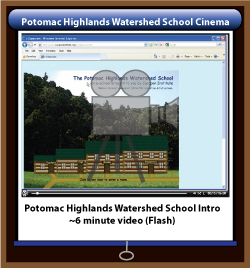 |
Potomac Highlands Watershed School What it is . . . |
 |
|
Because Cacapon Institute works in water quality monitoring and watershed conservation, this program is most relevant to science, geography, environmental science, and vocational agriculture classes. However, many of the activities also provide an opportunity to practice graphing, writing, and math. They also give students a chance to learn about inter-relationships, the role of science in society, civics, human health, use of technology, and to discuss current events. The Elementary, Middle and High school classrooms include:
The High School also offers the eForum Telephone, the entry point to Environmental Forums where students and teachers explore regionally important environmental issues in depth. Students work both as a class and with other students across the internet to understand problems and to seek solutions that are broadly acceptable to their communities. Learn more about the eForums here. The Teacher's Room contains detailed lesson plans for elementary, middle and high school activities. It also contains an eForum updates link that provides teacher instructions and updates for active forums.
All content on this site was developed by Cacapon Institute staff. Classroom art by Neil and Jennifer Gillies. Flash activities Watershed Puzzle, Watershed Creator, Stream Cleaner, and Decision Matrix were programmed by Luke Fleshman. Flash activity What is a Watershed was programmed by Jennifer Gillies and Neil Gillies. Flash activities "What is a Benthic Macroinvertebrate," "The Sedimentation Blues," Introduction to Stream Sampling", "What is it?" dichotomous keys, and "Virtual Stream Sampler" were programmed by Jennifer Gillies - and all benthic macroinvertebrate art was created by Jennifer Gillies using Adobe Illustrator. Content and "playability" were reviewed by partners at the Canaan Valley Institute, WV Conservation Agency, WV Division of Environmental Protection, WV Department of Agriculture, the USDA-Natural Resources Conservation Service, Friends of Deckers Creek, and teachers. We could not have done this without their help, but any and all errors are solely the responsibility of Cacapon Institute.
Beta testing was conducted by CI staff, Bob Markley, Vicki Fenwick, Shelby Pavlick, Tim Craddick (WVDEP), and Friends of Deckers Creek.
This website was made possible by grants from the US Environmental Protection Agency Environmental Education Program, Canaan Valley Institute, The MARPAT Foundation, Spring Creek Foundation, National Fish and Wildlife Foundation, NOAA-BWET and by donations by the members of Cacapon Institute. Content has been developed and reviewed by CI staff (Peter Maille, Meredith Pavlick, Neil Gillies, Frank Rodgers, Jennifer Gillies, Ben Alexandro), and volunteer Bob Markley. Any errors are solely the responsibility of Cacapon Institute. |
||
